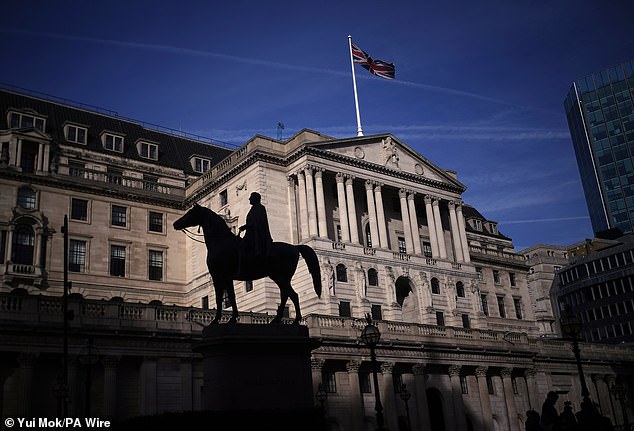- The bank’s MPC will meet to make a decision on interest rates on Thursday afternoon
- There is a possibility that the bank could choose to make cuts, but markets believe it will wait until June.
- Bank unlikely to risk hiking too quickly as Fed stagnates
The Bank of England could surpass the US Federal Reserve and the European Central Bank this week with a first cut in the base rate.
Markets are pricing in a small but growing chance that the Bank of England’s Monetary Policy Committee will opt to cut at its meeting on Thursday, following a more dovish tone taken at its April meeting and an expected sharp drop in upcoming monetary figures. inflation.
The Bank of England is expected to reduce the base rate twice in 2024, potentially taking it from its current level of 5.25 percent to 4.75 percent by the end of the year.
But forecasters say the scale of the Bank of England’s cuts will be limited by a slower start from the Federal Reserve, which faces a more persistent inflation outlook, amid concerns about the potential impact on sterling.
The Bank of England’s Monetary Policy Committee will meet on Thursday
Current market prices show a roughly 50 percent chance of the base rate falling to 5 percent after the May 9 and June 20 MPC meetings.
The bank may choose to wait until April inflation data is released later this month, amid expectations of a much lower reading and after falling to 3.4 percent in March.
April data will reflect a 12 percent annual drop in energy bills, as well as much lower inflation for basic goods, food and services, according to ING forecasts.

Official inflation data is expected to show a sharp drop in the next two months.
Nick Chatters, portfolio manager at Aegon Asset Management, said: ‘We are going to see a big drop in headline inflation in the April report.
‘This is going to be important from an optical point of view for the market, but we know it is coming.
“The bank’s communication so far, which is completely reasonable, is that a rate cut is still on the table for June, but it will depend on any surprises in that (CPI) figure: we could see a print below 2 percent. which optically would be very important.’
Markets are now also almost certain of an imminent cut in eurozone interest rates in June, following the ECB’s recent dovish comments, improving growth data and falling inflation.
But Chatters warned that both the Bank of England and the ECB will likely be forced to make a maximum of two cuts this year amid concerns from the Federal Reserve.
He said: “Going into 2024, we had six Fed cuts planned for the end of this year; now we have just over one and we’ve seen inflation go off course.”
“The Bank of England and the ECB can easily get started (with rate cuts), but they can’t go ahead without the Fed.”

US consumer price inflation remains stubbornly high
Can the Bank of England act before the Federal Reserve?
One factor weighing on the chances of a Bank of England cut is the knowledge that widening the interest rate gap between the UK and the US would cause sterling to fall against the dollar, which would have a negative impact on capital flows and inflation.
Morgane Delledonne, head of investment strategy at Global US and other major currencies, will possibly be counterproductive in reducing inflation, since it would make imports more expensive, but it will undoubtedly improve the competitiveness of the regions and boost exports.
“The ECB and the Bank of England will likely leave current rates unchanged and will self-inflict a reduction in demand as long as they need to reduce inflation and as long as unemployment remains at record lows.”
The US Federal Reserve has recently calmed fears that it could opt for a rate hike, but markets still do not expect the US central bank to start making cuts until September or even November.
Kristina Hooper, chief global market strategist at Invesco, said there is a “chance” the Bank of England will cut rates on Thursday “especially after the Fed’s dovish behavior last week.”
He added: “If there is no rate cut this week, I fully expect a Bank of England to show dovishness and signal that rate cuts can begin this summer, most likely in June, as the European Central Bank is announcing.”
And ING analysts believe the “link” between Fed policy and the Bank of England is “often overstated,” giving the UK bank more room to deviate from the US rate cycle if it sees fit. prompt.
ING said: Concerns about the impact of a weaker currency have probably taken a backseat.
‘Not only is inflation much lower and there is greater confidence in disfination in process, but sterling has been one of the most resilient G10 currencies in the face of renewed dollar strength.
‘In a sense, that offers a bit of protection against any new weakness and transmission to inflation.
“In short, we don’t think the Bank of England will have many qualms about cutting rates before the Fed, or about moving a little faster at later meetings.”

Rate cut expectations for 2024 are rising in the UK relative to the US.


